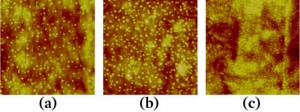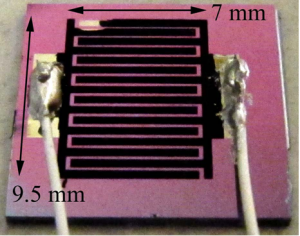Improved Carbon Nanotube Ultracapacitor Electrodes for Storage and Filtering
- Category: Electronic Devices, Energy, Materials, Nanotechnology
- Tags: carbon nanotubes, david jenicek, john kassakian
Due to their mechanical, thermal, and electrical properties and their natural ability to grow on a variety of metallic and non-metallic substrates [1] , carbon nanotubes (CNTs) have the potential to significantly enhance the performance of modern ultracapacitors [2] [3] . However, the energy density of these devices – the relevant metric for energy storage applications – still falls far below (about 20 x) that of modern lithium-ion batteries. We are investigating different fabrication techniques that enhance electrode energy density to make ultracapacitors more competitive. Specifically, we are targeting an elevated count of CNTs per unit area to increase the specific surface area of each electrode, which can be achieved by modifying the morphology of catalyst particles on the substrate prior to CNT growth. Figure 1 shows three atomic force microscope (AFM) images depicting the immense variability of catalyst nanoparticle size and density that has been demonstrated to date: particle counts range from (a) under 1×1010 cm-2 to (c) 3×1011 cm-2, and we expect a well-correlated rise in specific capacitance of a completed cell.
Additionally, we are investigating the integration of CNT-based ultracapacitors with MEMS-scaled devices. Our goal is to devise a fabrication process that is completely compatible with modern semiconductor manufacturing techniques. To date, we have successfully demonstrated the functionality of a 3.5 mF interdigitated-electrode capacitor measuring 7 x 9.5 mm, for an effective specific capacitance of 52.6 µF/mm2(about two orders of magnitude above state-of-the-art trench capacitors [4] ). A photograph of the completed device is provided in Figure 2. Future work will focus on making improvements to the equivalent series resistance and time constant of the device, as well as packaging.
- Figure 1: Three 1×1µm AFM images depicting the achieved variability in catalyst particles prior to CNT growth. Nanoparticles range in diameter and density from (a) 18 nm and 1×1010 cm-2 to (c) 8 nm and 3 x 1011 cm-2. Color scale is from 0 (dark) to 20 nm (light).
- Figure 2: Photograph of lithographically patterned interdigitated-electrode capacitor before wetting with electrolyte.
- J. A. Hart, “Chemical, Mechanical, and Thermal Control of Substrate-Bound Carbon Nanotoube Growth,” Ph.D. Thesis, Massachusetts Institute of Technology, Cambridge, MA, 2006. [↩]
- R. Signorelli, “High Energy and Power Density Nanotube-Enhanced Ultracapacitor Design, Modeling, Testing, and Predicted Performance,” Ph.D. Thesis, Massachusetts Institute of Technology, Cambridge, MA, 2009. [↩]
- R. Signorelli, D. C. Ku, J. G. Kassakian, and J. E. Schindall, “Electrochemical Double-Layer Capacitors Using Carbon Nanotube Electrode Structures.” Proceedings of the IEEE, vol. 97, no. 11, pp. 1837-1847, 2009. [↩]
- M. D’Asaro, D. Jenicek, S. Mountjoy, J. Schindall, and J. Kassakian, “Miniature Carbon-Nanotube-Enhanced Ultracapacitor for Electronics Applications,” presented at 21st International Seminar on Double Layer Capacitors & Hybrid Energy Storage Devices, 2011, Fort Lauderdale, FL. [↩]

